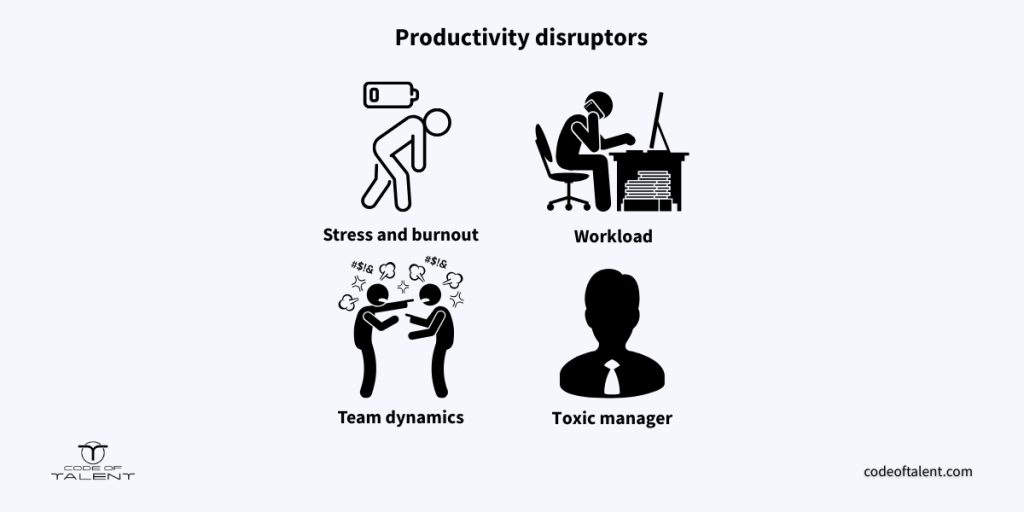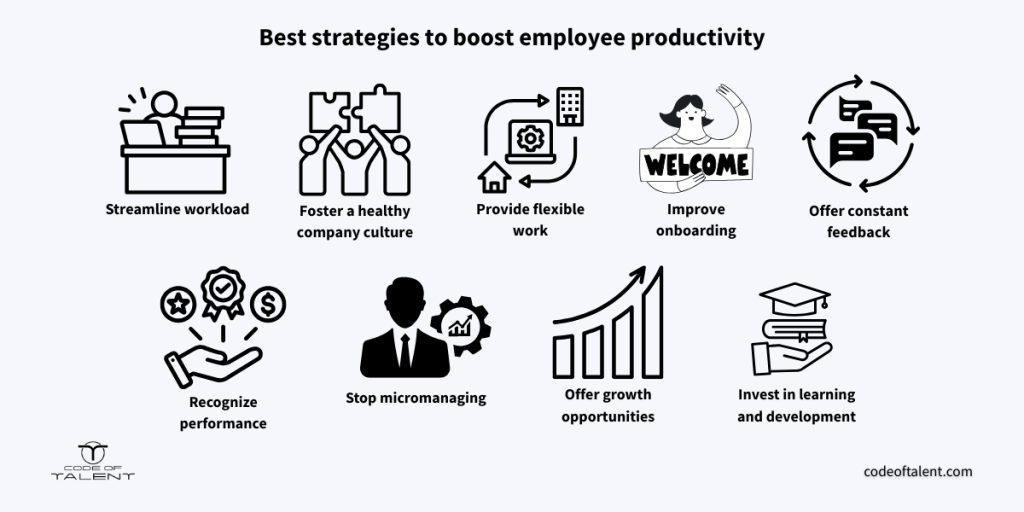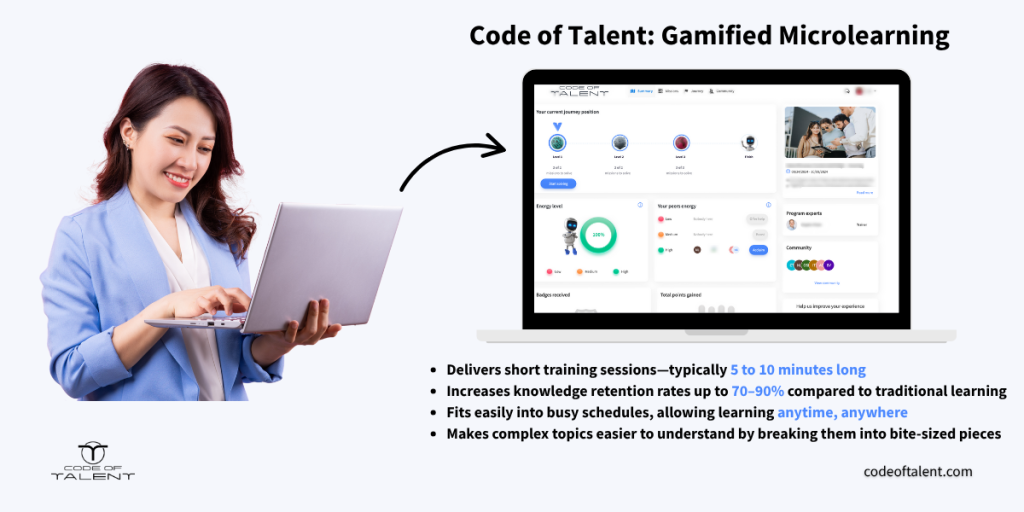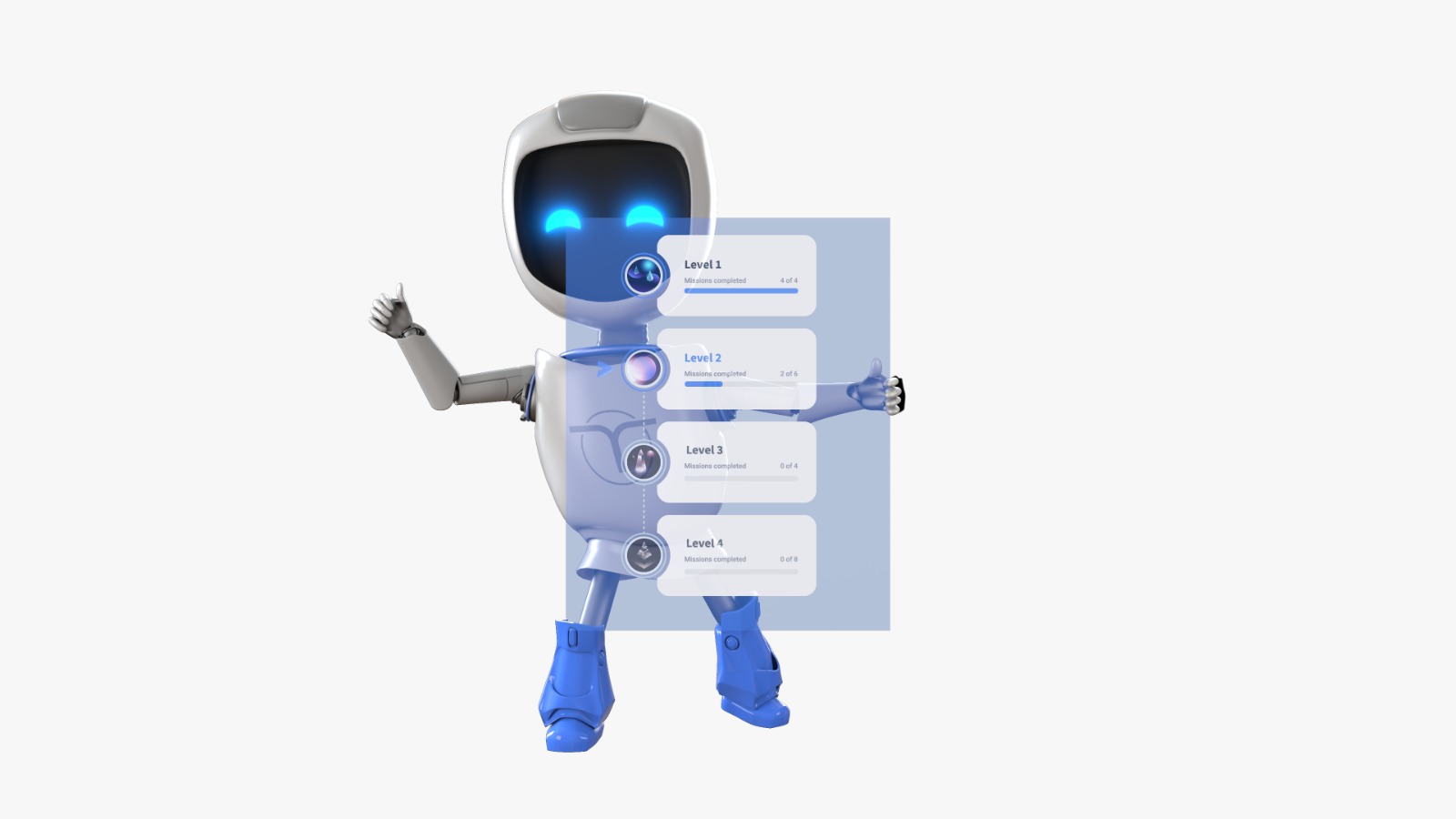$8.9 trillion. That’s how much disengaged employees are costing the global economy every year, nearly 9% of global GDP, according to Gallup. And chances are, it’s quietly draining your business too. If you’re looking to boost employee productivity, the solution isn’t more pressure or longer hours, but smarter systems, better alignment, and a clear plan. In this article, we’ll walk through exactly how to do that.
What Impacts Productivity?
Productivity is the result of multiple, often interconnected factors—some visible, others hidden beneath the surface. If you want to boost employee productivity, you need to address the underlying issues holding people back. Here are four key productivity blockers to watch for:

1. Chronic Stress and Burnout
Stress is one of the most common and costly drains on productivity. It affects focus, energy, and motivation, and over time, it leads to burnout, absenteeism, and turnover. According to Oak’s 2024 Mental Health in the Workplace report, 58% of workers have experienced mental or physical stress caused by work within the past two years.
Simply put, stress harms both the employees’ well-being and performance.
2. Unmanageable Workloads
Even the most motivated employees struggle to stay productive when they’re constantly overwhelmed. A VoucherCloud survey revealed that the average office worker is only productive for 2 hours and 53 minutes per day. The rest of the time is spent navigating unclear priorities, bloated meeting schedules, or just mentally checking out.
3. Team Dynamics
The way people interact matters. Misaligned goals, poor communication, or a lack of collaboration can drag down even the most talented teams. On the flip side, positive team dynamics, such as mutual trust, clear roles, and psychological safety, are proven to improve productivity, decision-making, and innovation.
4. Toxic Management
Few things erode productivity faster than toxic leadership. Micromanagement, lack of trust, or public criticism create fear-based environments where people underperform, disengage, or quit.
Great leaders, by contrast, empower employees to own their work and perform at their best.
Create a Plan to Boost Employee Productivity
Improving productivity requires a structured approach, tailored to your team and business goals. Here’s how to build a productivity plan that delivers results:

1. Measure Productivity Using the Right KPIs
Before you can improve productivity, you need to know where you stand. That starts with identifying the right Key Performance Indicators (KPIs), both qualitative and quantitative, based on roles and responsibilities.
Some useful productivity KPIs include:
- Output per employee (tasks completed, sales closed, etc.)
- Project completion rates and timeliness
- Time spent on high-value tasks vs. low-value work
- Absenteeism and turnover rates
- Customer satisfaction (for client-facing roles)
- Engagement metrics
2. Set Clear, SMART Goals
Once you’ve identified what needs improvement, define clear goals to guide your plan. These goals will shape your strategy, so if they’re vague or unrealistic, momentum will stall before it begins.
Take this common example: “Have better retention rates.”
In this form, it mostly illustrates a want rather than an action plan. Consider using the SMART framework instead, in which goals are:
- Specific – Clear and focused
- Measurable – Tied to data or outcomes
- Achievable – Ambitious but realistic
- Relevant – Connected to business priorities
- Time-bound – Set against a clear deadline
Using this approach, the earlier goal becomes: “Increase employee retention by 10% by the end of the fiscal year by launching a 90-day onboarding program with defined milestones for new hires.”
3. Align Goals with Team Leaders and Employees
Before diving into any productivity plan, bring everyone on board: employees and managers alike. This starts with clear communication and transparency. According to The Alternative Board, 56% of entrepreneurs say better communication is the best way to improve productivity across their business.
Employees should understand why improving productivity matters not just for the company, but for them as individuals:
- Less stress
- Clearer expectations
- More recognition
- Better growth opportunities.
Meanwhile, managers play a central role here: they’re the ones connecting strategy to execution and keeping teams motivated and supported.
4. Monitor Productivity and Take Action
Even the best plans need real-time monitoring: track progress, spot red flags early, and adapt when needed. The goal is not to micromanage, but to stay responsive and support your team while continuously improving the system.
Key practices include:
- Weekly or biweekly performance check-ins
- Real-time dashboards or productivity software
- Open conversations about what’s working (and what’s not)
- Intervening early when someone’s stuck
Best Strategies in Developing a Plan to Boost Employee Productivity
Once your goals are clear and your team is aligned, it’s time to bring your productivity plan to life. The following strategies aren’t one-size-fits-all, but they create a strong foundation that can be tailored to your organization’s needs.
1. Streamline Workload and Work Systems
Too many meetings, inefficient workflows, and outdated tools can drain time and energy.
Start by:
- Cutting back on meetings: Keep them short, agenda-led, and outcome-driven
- Sending clear summaries afterward: So no one is left guessing
- Providing IT and technical training: Ensure teams know how to fully use the tools at their disposal
2. Foster a Healthy, Positive Workplace Culture
People thrive in supportive, balanced environments, but building such a system requires sustained cultural shifts, both organizational and psychological. Productivity improves when employees feel genuinely supported, not just occasionally encouraged.
This means:
- Encouraging healthy boundaries: No after-hours emails, no calls during vacation, and a clear right to disconnect after work hours.
- Offering mental wellness support: Provide discounted therapy, free sessions, or in-house wellness workshops. A clinical study found that employers saved $580 per employee who actively used mental well-being tools.
- Inspiring positivity intentionally: Use encouraging internal messaging to boost morale and connection.
3. Provide Flexible Working Options
Global Workplace Analytics found that two-thirds of people want to work from home, and 36% would choose it over a pay raise. In the post-pandemic context, flexibility has become a deal breaker not only to employees’ well-being but to their productivity as well.
Give employees the autonomy to work when and where they’re most effective, whether that means remote, hybrid, or flexible work. Beyond that:
- Offer mental health days
- Make sick leave more accessible
- Give time off for education or development.
4. Improve Onboarding: Set the Tone from Day One
Strong performance starts with a strong welcome, so this is why onboarding is the first opportunity to set someone up for success. In fact, research shows that effective onboarding can increase new employee productivity by over 70%.
To build an onboarding process that drives performance:
- Start early: Share a schedule, tools, and goals before day one
- Structure the first weeks: Map out key milestones
- Assign a mentor or buddy: Social support builds confidence fast
- Connect them to the mission: Show how their role contributes to the bigger picture
5. Create a Feedback-Driven Culture
Feedback isn’t just for performance reviews. Ongoing, two-way conversations help employees grow, feel heard, and stay aligned with expectations.
Establish:
- Regular 1:1 check-ins with managers
- Project-based feedback from team leads
- Peer feedback to encourage collaboration and continuous improvement
6. Recognize and Reward Performance
Recognition motivates. It shows employees their contributions are seen, appreciated, and valuable. There are many ways to recognize employees, and the best programs blend both tangible and emotional rewards:
- Paid recognition: Bonuses, spot awards, gift cards, raises, or even extra PTO days tied to performance milestones.
- Non-paid recognition: Public praise in team meetings, shoutouts in internal newsletters, handwritten thank-you notes, or a quick message on Slack highlighting someone’s great work.
7. Stop Micromanaging
Micromanagement wears people down and makes them second-guess themselves, as they wait for approval on every small task and slowly lose confidence in their own judgment.
We’ve all seen how that plays out: projects take longer, people stop taking initiative, and creativity fades over time.
Instead, invest in leadership development so managers can lead through trust, not control. Strong leaders delegate, support, and create space for others to step up. That’s when real productivity and innovation starts to take off.
8. Offer New Growth Opportunities
Employees often disengage when work becomes repetitive. It’s no surprise that one of the most common tips for avoiding burnout is to try something new and step outside routine tasks.
Break the cycle of repetition and boredom by giving employees opportunities to grow in fresh, meaningful ways:
- Join cross-departmental projects
- Participate in innovation sprints or pilot programs
- Explore leadership shadowing or mentorship paths
9. Invest in Learning and Development
When you invest in people, they invest in their work. A Better Buys study found that employees who receive professional development are 15% more engaged and have 34% higher retention, a strong signal that learning opportunities fuel both motivation and loyalty.
Start small
You don’t need to launch a full-scale program right away. Even lightweight efforts show your team that growth is a priority:
- Offer free books or paid book subscriptions
- Give access to curated podcast lists or online courses
- Block time for learning during the workweek
Then scale up
Surface-level learning can only take you so far. To truly boost employee productivity, you need more than scattered resources.
A structured productivity training program empowers employees with the tools, mindset, and skills they need to work smarter and stay engaged long-term. It connects personal growth with business goals.
With the right framework, you can:
- Identify the specific productivity gaps in your team
- Deliver learning that’s practical, relevant, and immediately applicable
- Track progress and measure ROI with real outcomes, not just course completions
When learning becomes part of your culture, not just an afterthought, it transforms how people show up to work. That’s the difference between temporary improvement and lasting performance.
Explore our full guide on how to build an effective productivity training strategy [here] (insert link).
Boost Employee Productivity with Code of Talent
Code of Talent is a smart, scalable microlearning platform designed to help companies turn training into real-world performance.
With Code of Talent, you can:
- Design personalized learning journeys tailored to each role or business goal
- Deliver bite-sized, mobile-first content that fits into your team’s workday, with no disruptions or wasted hours
- Track engagement and performance with powerful analytics, so you know what’s working
- Foster collaboration and accountability through peer feedback and real-time interaction
Whether you’re onboarding new hires, upskilling teams, or rolling out a company-wide productivity initiative, Code of Talent makes training accessible, engaging, and effective.

When training is done right, performance follows. Learn more about Code of Talent and how it can help your teams learn better and perform stronger and try our free trial to boost employee productivity through intentional, targeted training!
Cover photo: Freepik





